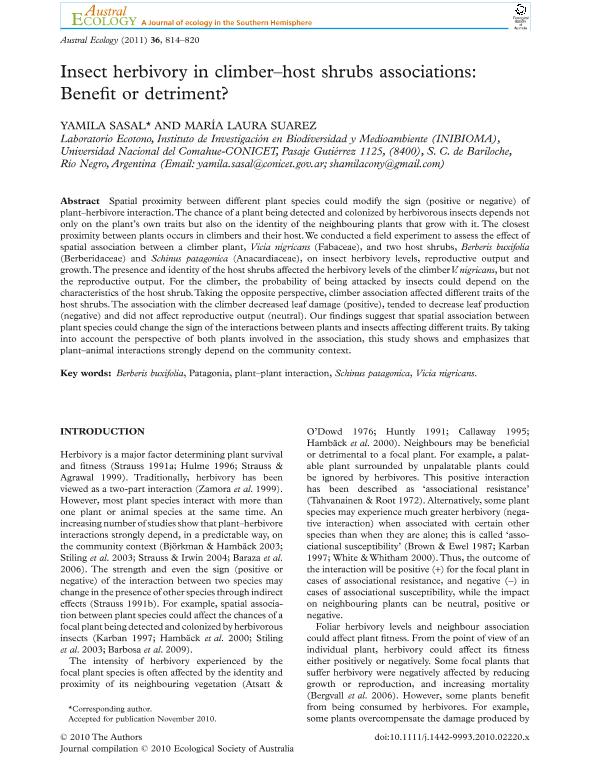Mostrar el registro sencillo del ítem
dc.contributor.author
Sasal, Yamila

dc.contributor.author
Suarez, Maria Laura

dc.date.available
2019-05-13T20:40:33Z
dc.date.issued
2011-11
dc.identifier.citation
Sasal, Yamila; Suarez, Maria Laura; Insect herbivory in climber-host shrubs associations: Benefit or detriment?; Wiley Blackwell Publishing, Inc; Austral Ecology; 36; 7; 11-2011; 814-820
dc.identifier.issn
1442-9985
dc.identifier.uri
http://hdl.handle.net/11336/76204
dc.description.abstract
Spatial proximity between different plant species could modify the sign (positive or negative) of plant-herbivore interaction. The chance of a plant being detected and colonized by herbivorous insects depends not only on the plant's own traits but also on the identity of the neighbouring plants that grow with it. The closest proximity between plants occurs in climbers and their host. We conducted a field experiment to assess the effect of spatial association between a climber plant, Vicia nigricans (Fabaceae), and two host shrubs, Berberis buxifolia (Berberidaceae) and Schinus patagonica (Anacardiaceae), on insect herbivory levels, reproductive output and growth. The presence and identity of the host shrubs affected the herbivory levels of the climber V. nigricans, but not the reproductive output. For the climber, the probability of being attacked by insects could depend on the characteristics of the host shrub. Taking the opposite perspective, climber association affected different traits of the host shrubs. The association with the climber decreased leaf damage (positive), tended to decrease leaf production (negative) and did not affect reproductive output (neutral). Our findings suggest that spatial association between plant species could change the sign of the interactions between plants and insects affecting different traits. By taking into account the perspective of both plants involved in the association, this study shows and emphasizes that plant-animal interactions strongly depend on the community context.
dc.format
application/pdf
dc.language.iso
eng
dc.publisher
Wiley Blackwell Publishing, Inc

dc.rights
info:eu-repo/semantics/openAccess
dc.rights.uri
https://creativecommons.org/licenses/by-nc-sa/2.5/ar/
dc.subject
Berberis Buxifolia
dc.subject
Patagonia
dc.subject
Plant-Plant Interaction
dc.subject
Schinus Patagonica
dc.subject
Vicia Nigricans
dc.subject.classification
Otras Ciencias Biológicas

dc.subject.classification
Ciencias Biológicas

dc.subject.classification
CIENCIAS NATURALES Y EXACTAS

dc.title
Insect herbivory in climber-host shrubs associations: Benefit or detriment?
dc.type
info:eu-repo/semantics/article
dc.type
info:ar-repo/semantics/artículo
dc.type
info:eu-repo/semantics/publishedVersion
dc.date.updated
2019-04-23T15:05:45Z
dc.journal.volume
36
dc.journal.number
7
dc.journal.pagination
814-820
dc.journal.pais
Reino Unido

dc.journal.ciudad
Londres
dc.description.fil
Fil: Sasal, Yamila. Consejo Nacional de Investigaciones Científicas y Técnicas. Centro Científico Tecnológico Conicet - Patagonia Norte. Instituto de Investigaciones en Biodiversidad y Medioambiente. Universidad Nacional del Comahue. Centro Regional Universidad Bariloche. Instituto de Investigaciones en Biodiversidad y Medioambiente; Argentina
dc.description.fil
Fil: Suarez, Maria Laura. Consejo Nacional de Investigaciones Científicas y Técnicas. Centro Científico Tecnológico Conicet - Patagonia Norte. Instituto de Investigaciones en Biodiversidad y Medioambiente. Universidad Nacional del Comahue. Centro Regional Universidad Bariloche. Instituto de Investigaciones en Biodiversidad y Medioambiente; Argentina
dc.journal.title
Austral Ecology

dc.relation.alternativeid
info:eu-repo/semantics/altIdentifier/doi/http://dx.doi.org/10.1111/j.1442-9993.2010.02220.x
dc.relation.alternativeid
info:eu-repo/semantics/altIdentifier/url/https://onlinelibrary.wiley.com/doi/abs/10.1111/j.1442-9993.2010.02220.x
Archivos asociados
